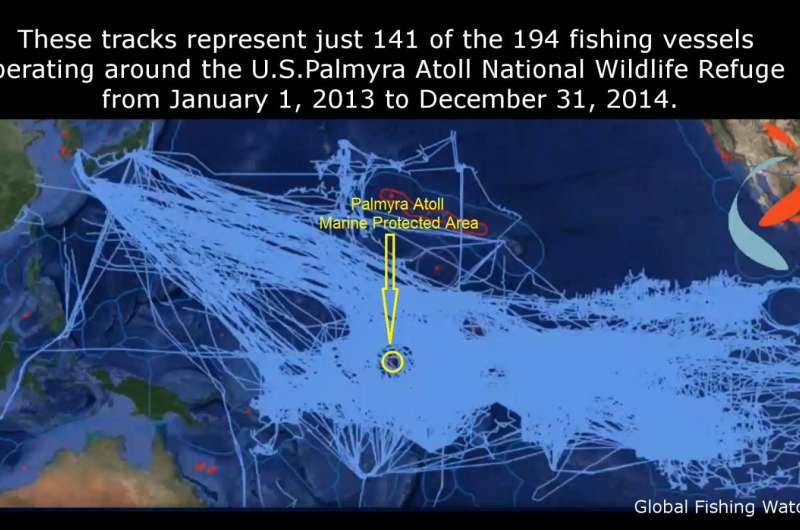Large marine protected areas effectively protect reef shark populations

Researchers at Stanford University's Hopkins Marine Station investigated the role of expanded marine protected areas (MPAs) on grey reef sharks and found that the aquatic no-fishing zones were an effective tool for protecting this near-threatened species.
Originating 423 million years ago, sharks are a group of predators that span 490 species and still play crucial roles within their ecosystems. We often characterize these top predators as nearly indestructible monsters but, of course, that's far from the reality: They mature slowly, they don't have high numbers of offspring, and they're under serious threat due to the value of their fins.
For their study, the team tracked both sharks and fishing vessels in the U.S. Palmyra Atoll National Wildlife Refuge, a large MPA about 1,000 miles (1,600 kilometers) south of Hawaii. Their findings, published in the Jan. 31 issue of Biological Conservation, provide valuable evidence that these areas are worth creating and maintaining.
"These techniques showed for the first time that large MPAs are effective tools for protecting declining shark populations and other mobile marine predators that are not adequately protected by smaller, coastal MPAs," said Fiorenza Micheli, professor of marine science at Hopkins Marine Station and co-author of the paper.
Not only did they find little evidence of fishing within the refuge, they saw that there was a surprisingly high density of ships just outside its boundaries, suggesting that even remote locations are primed for significant fishing if protection were to disappear.
Questioning the value of protection
Marine protected areas have been around for decades but they've mostly been near the coasts and rather small, with 1 square mile being a typical size. Recently, much larger MPAs have been established in waters far from large human populations. In 2016 alone, the title of "largest MPA" changed hands twice. In August, the U.S. Papahānaumokuākea Marine National Monument off the coast of Hawaii was the largest ever established but soon that title went to the Ross Sea Protected Area in Antarctica, collaboratively designated by 24 countries, including the United States, and the European Union.
"Some of these protected areas are twice the size of Texas and they've been very recently established, so they hold great conservation potential," said Tim White, a graduate student at Hopkins Marine Station and lead author of the study. "But we're not sure of the effects that these marine protected areas will have on a range of species."
A substantial question is whether working to protect ocean far from well-populated land is worth the effort or whether that work would be better used to create more traditional, smaller MPAs. Another concern is whether these areas do much to support mobile species, like sharks, which can come and go from the protected waters as they please.
Tagging sharks and watching ships
To monitor the movement of the sharks, the researchers used both conventional numbered tags and satellite-enabled tags. The first method is cheap and can cover large numbers of sharks - they tagged 262 this way - but relies on the return of tags to the researchers by fishers who catch the sharks, which is a rare occurrence. The second method allows the researchers to track the sharks' movement by satellite, but each tag is very expensive. They attached satellite tags to 11 sharks.

Devices called automatic identification system (AIS) transceivers helped the researchers identify the movement of distant fishing vessels. Boats are equipped with these devices in order to let each other know their identities and locations in order to avoid collisions. They can also transmit additional information, such as the size and type of boat. By collecting this publicly available data and applying an algorithm previously developed by Global Fishing Watch, a partnership between Oceana, SkyTruth and Google, the researchers figured out where and when each vessel was likely to be fishing.
The combination of these tools meant that the researchers could track shark and fishing activity throughout the large, remote reserve. What they found suggests that the expanded MPAs are working. There were more sharks in the MPA than outside and the majority stayed within its limits. Fishing vessels almost exclusively sat outside the boundaries but they were there in unexpected abundance, nearly 200 ships from 12 countries over the course of two years.
Another discovery was that one of the grey reef sharks, so-named because they are considered reef dwellers, swam more than 575 miles (925 km) from the atoll where it was tagged and spent 97 percent of its time in open water. Additional tags recovered at various islands further suggested that grey reef sharks may swim longer distances than previously thought.

For sharks, fishermen and tourists
Balancing all the different impacts of MPAs isn't easy but the researchers believe preserving sharks has benefits for both ocean-dwellers and people. Keeping shark numbers healthy supports ecosystem health and this, in turn, can bring in millions in tourism dollars because people prefer to visit healthy reefs.
As shown by this research, greater insight into what goes on in and around protected areas can also fill existing gaps in our knowledge of their occupants, like the maybe not-so-aptly-named grey reef shark.
"It is extremely difficult to understand what are the baselines of shark populations and what oceans looked like before the rise of industrial fishing," said Giulio De Leo, professor of biology at Hopkins Marine Station and co-author of the paper. "Large marine protected areas located in such remote places provide us with an opportunity to have a glimpse of the past, of how the oceans functioned before we started to systematically harvest them."
The researchers plan to continue to study this area of the Pacific. The levels of human influence on the waters around these islands vary widely and, therefore, offer a unique display of how our actions impact ocean ecosystems.
More information: Timothy D. White et al, Assessing the effectiveness of a large marine protected area for reef shark conservation, Biological Conservation (2017). DOI: 10.1016/j.biocon.2017.01.009
Journal information: Biological Conservation
Provided by Stanford University


















